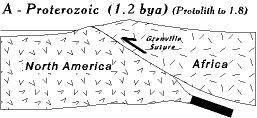 Cross Section A (Next Cross Section ) (Previous Cross Section) (Home) The Grenville: A Major Mountain Building Event Late Proterozoic; 1.8 - ~1.1 bya  Every building has a foundation, some basement on which it rests. In geology the basement refers to the igneous and metamorphic rocks that form the core or base of a continent, and underlie the younger sedimentary rocks stacked on top. Even though basement rocks underlie all of a continent they are usually only exposed in old mountain ranges where uplift and erosion has stripped away all the overlying rock. In Virginia the basement rocks are called the Grenville, and they contain the oldest record in our history, a mountain building event of major proportions. Grenville rocks are found all up and down eastern North Amnerica from Newfoundland to North Carolina. They are the oldest rocks along the east coast and have had a long, complex history that culminated in the Grenville orogeny (mountain building event) of 1.1 billion years ago. The orogeny occurred when "Africa"(A2) collided and overrode the edge of North America (cross section at top of page) to build a mountain range likely the size of the Himalayas (Mt. Everest is nearly 30,000 feet high). In Virginia, Grenville rocks are most obvious in the Blue Ridge province. The Blue Ridge province includes both the Blue Ridge mountains (along which Skyline Drive runs) and the strip of land just to the east of the mountain running from Galax north through Charlottesville, Culpepper, Warrenton and beyond. The rocks today are found in an overturned anticline (A1) whose core contains the Grenville rocks. And then flanking both sides of the anticline are younger lava flows and sedimentary rocks originally deposited on top of the Grenville basement (in the cross section including the Catoctin lava flows, and Lynchburg and Chilhowee sediments). Basement rocks always form deep, so at the time these Blue Ridge Grenville rocks formed a large mountain range existed, and the land surface was somewhere far above our heads. We can only speculate what Virginia looked like during Grenville time. Only fragments of the deep forming rocks are preserved. But imagine standing next to some of these rocks along Skyline Drive, or at Old Rag Mountain. What would conditions be like if we could have been there at the time they were forming? The pressure would be crushing; if normal atmospheric pressure at sea level is 68 kilograms/cm2 (15 pounds/in2), 10 km down it is over 30,000 atmospheres of pressure. And it would be hot. The Grenville igneous rocks began as magma (liquid rock), so at the time of their formation we would be surrounded by seething, glowing, red hot liquid rock, swirling and surging in large chambers intruding their way (emplacing) into the mountain core. Not quite the scene we see when driving along Skyline drive today. The metamorphism of the Grenville rocks took place at temperatures and pressures nearly as high as igneous rocks, but for the most part later in Virginia's history. Over the next several hundred million years after the Grenville mountains formed they eroded away, eventually exposing these deep forming rocks at the surface. It was on this surface that the thick sedimentary pile of the rest of Virginia's history was to accumulate beginning in the Late Proterozoic and Cambrian about 600 million years ago (mya). Eventually this sedimentary pile reached thousands of feet of thickness. Note that the Pre-Cambrian exposure of the Grenville rocks is not the same exposure of these rocks we see today in the Blue Ridge. To get today's exposure will take nearly another 500 million years, and will include a first rifting event to open a Proto-Atlantic ocean basin, three more mountain building events to close that ocean (one Wilson cycle), and then a second rifting event to open the Atlantic ocean (first half of a second Wilson cycle). During all these evetns sedimetnary rocks accumulate, layer by layer, by layer. All these layers must pile up, then be deformed into a mountain, then eroded down again before the rocks we see in the Blue Ridge today are exposed. Clearly there is a lot of history ahead of us. So now we move to the next event in Virginia's geologic history, the rifting that opened the Proto-Atlantic ocean, Stage B.
|